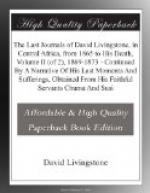The ancient Africans seem to have been at least as early as the Asiatics in the art of taming elephants. The Egyptian monuments show them bringing tame elephants and lions into Egypt; and very ancient sculptures show the real African species, which the artist must have seen. They refused to sell elephants, which cost them months of hard labour to catch and tame, to a Greek commander of Egyptian troops for a few brass pots: they were quite right. Two or three tons of fine fat butcher-meat were far better than the price, seeing their wives could make any number of cooking pots for nothing.
15th July, 1872.—Reported to-day that twenty wounded men have been brought into M’futu from the field of fighting. About 2000 are said to be engaged on the Arab side, and the side of Mirambo would seem to be strong, but the assailants have the disadvantage of firing against a stockade, and are unprotected, except by ant-hills, bushes, and ditches in the field. I saw the first kites to-day: one had spots of white feathers on the body below, as if it were a young one—probably come from the north.
17th July, 1872.—Went over to Sultan bin Ali yesterday. Very kind, as usual; he gave me guavas and a melon—called “matanga.” It is reported that one of Mirambo’s chief men, Sorura, set sharp sticks in concealed holes, which acted like Bruce’s “craw-taes” at Bannockburn, and wounded several, probably the twenty reported. This has induced the Arabs to send for a cannon they have, with which to batter Mirambo at a distance. The gun is borne past us this morning: a brass 7-pounder, dated 1679. Carried by the Portuguese Commander-in-Chief to China 1679, or 193 years ago—and now to beat Mirambo, by Arabs who have very little interest in the war.




